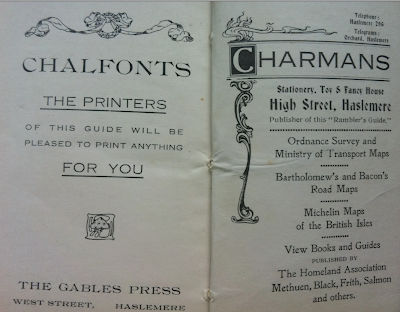I keep on returning to Arthur Romney Green. After discovering that his workshop still exists in Haslemere, and that it is next door to my house(!) I have found some additional articles on Arthur Romney Green. His obituary from Christchurch Times (3 March 1945) gives a good overview of his life, and the title of the article "Borough loses noted craftsmen, a gifted personality" conveys a great respect for his talents:
"A GREAT loss has been sustained by his friends in the artistic world, and the Borough generally, by the death, following a cycle accident, of a sailor, poet and craftsman, Mr. Arthur Romney Green, of 3, Bridge Street.
 |
Arthur Romney Green,
Christchurch Times, 3 March 1945 |
"Mr. Green had lived at Christchurch for the past 25 years, and had been noted for the exhibitions of his work in furniture design at the Bournemouth Arts Club shows. He also lectured on crafts to the Literature and Art Society. To a visitor passing down Bridge Street, the name of A. Romney Green, woodworker and designer, displayed above his little shop, conveyed little or nothing. Yet few could fail to be attracted by the examples of carpentry conspicuous within.
"It was there that Mr. Green lived and modelled from walnut, pine, cedar and other woods for many years. Graduated from Cambridgewith mathematical honours, he had since distinguished himself in the annals of carpentery and his work is recognised all over the country. A Batchelor of Arts, Mr. Green had for some years carried on teaching in South Africa. Quite recently he broadcast from the B.B.C. on the lighter side of his profession. It was his second broadcast within six months: his first transmission in May attracted a hundred letters. His furniture, which he made himself, is all designed geometrically and worked out with mathematical accuracy, which he considered enhanced its beauty. His combined workshop and residence is a veritable storehouse of every conceivable piece of furniture of a quality which indicates the touch of a master craftsman. Adorning his walls and strewn amongst finished models, are illustrations and pictures connected with his profession.
 |
Arthur Romney Green c. 1920s (in the dark jacket on the doorstep)
from Elkin, Susan, Life to the Lees, Cromwell Press, 1998 |
"Mr. Green had every reason to be proud of his handiwork. Examples had been exhibited with the Arts and Crafts Exhibition Society, and through the medium of the Board of Trade and the Ministry of Education, in international exhibitions at Paris. Milan and St. Louis. A strange but interesting aspect of his career was that despite the wide spread popularity of his work he had never travelled a great deal. The quality of his work was so recognised that prospective buyers willingly came to him and not he to them. His many clients since the last war included several Peers.
"One of the most beautiful examples of his creative art was a lectern modelled in yew and chestnut for the war memorial of St Georges School, Hartington. Undertakings had also been received from Charterhouse School. Examples of his fine work can be seen locally. The lectern and oak wood work of the Lady Chapel of the Priory Church was carried out by Mr. Green and his staff. He also made furniture for the late Eric Gill, sculptor and scribe, with whom he had been associated in some of his work.
"His business was not entirely immune from the effects of war. Despite the fact that as a small working master he had experienced an acute staff shortage, the standard of his work still maintained its high level. It was his firm belief that the authorities should do all they could to foster the formation of these small workshops after the war in order to develop that creative impulse so prevalent in British people.
"A native of Strand-on-the-Green, Middlesex, he leaves one surviving daughter, his wife having died two years ago. His brother, a well-known architect, Mr. W. Curtis Green, R.A., whose designs included those for the Dorchester Hotel, London.
"Another of Mr. Green's interests was financial reform, in connection with which he had corresponded with Lord Keynes and contributed to the “New English Weekly.
"The interment took place at the Christchurch Cemetery on Saturday, February 24th. the service being conducted by the Rev. Woodhams. The family mourner was the brother of Mr. Green, Mr. Curtis Green. Also present were: Mrs. Leslie Goodwin, Mrs. Garle, Mr. Julian Taylor, Mr. A. Scott and Mr. and Mrs. F.D. Lane."










